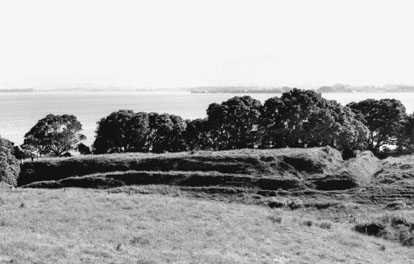

 | Page 943 |  |
hunter-forager (moa hunting) camps and low populations through to nuclear-centered pa with a large population supported by agriculture based on the storage of seed kumara. After his work encountered some criticism, Green (1974) largely abandoned his finer subdivisions of the archaic and classic but retained the explanatory scenario of an adaptation to deteriorating environmental circumstances, now humanly induced, as the motive behind the shift to systematic agriculture.

Pa defended by a ditch and bank system, Kauri Point, Katikati
(Department of Anthropology, University of Auckland)
Arguing that the extent of economic and cultural change during the prehistoric period had been overestimated, Leslie Groube (1964, 1967, 1969) launched an ambitious attack on the findings of Duff, Golson, and Green. Groube argued that the definition of Duff’s Maori period and that of Golson’s classic phase were compromised by the use of nineteenth-century ethnographic accounts, which masked the extent of change that closely followed the arrival of the Europeans. Noting that the least change had occurred on the South Island, the area with the greatest climatic contrast with island Polynesia, Groube suggested that the later Maori culture was little different than that introduced by the initial Polynesian settlers. The changes in adze forms and ornaments, on which the definition of the archaic and classic largely depended, were the result of stylistic rather than functional changes. He also argued that distinctive greenstone hei-tiki (small ornaments with a humanlike form), carved storage houses, and decorated meeting houses reflected post-European alterations in wealth, trading opportunities, and the availability of iron carving tools. Using kwang-chi chang’s (1958) division of settlements into households and communities to test Green’s model of evolution, Groube concluded that there was little evidence for a change from simple to complex settlements in New Zealand.
The attack on the archaeological credibility of Golson’s archaic and classic phases was effective, and it, together with the realization that the majority of North Island archaeological sites contained few if any portable artifacts that would enable the employment of the culture-historic method (Golson 1965; Terrell 1965), pushed New Zealand archaeologists to examine the archaeological record to see if other phenomena might do the job. Golson (1957), but
 |  |